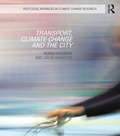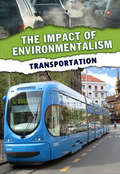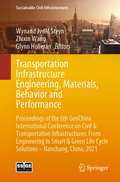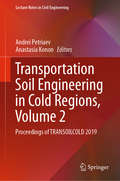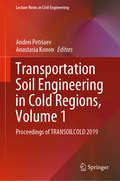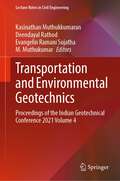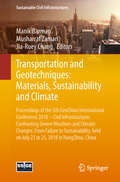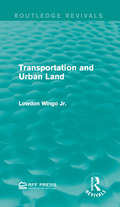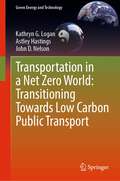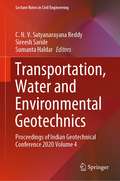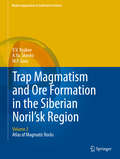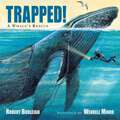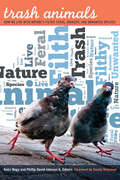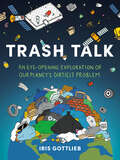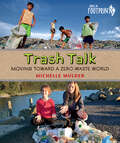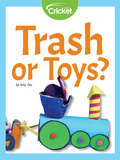- Table View
- List View
Transport, Climate Change and the City (Routledge Advances in Climate Change Research)
by David Banister Robin HickmanSustainable mobility has long been sought after in cities around the world, particularly in industrialised countries, but also increasingly in the emerging cities in Asia. Progress however appears difficult to make as the private car, still largely fuelled by petrol or diesel, remains the mainstream mode of use. Transport is the key sector where carbon dioxide (CO2) emissions seem difficult to reduce. Transport, Climate Change and the City seeks to develop achievable and low transport CO2 emission futures in a range of international case studies, including in London, Oxfordshire, Delhi, Jinan and Auckland. The aim is that the scenarios as developed, and the consideration of implementation and governance issues, can help us plan for and achieve attractive future travel behaviours at the city level. The alternative is to continue with only incremental progress against CO2 reduction targets, to ‘sleepwalk’ into climate change difficulties, oil scarcity, a poor quality of life, and to continue with the high traffic casualty figures. The topic is thus critical, with transport viewed as central to the achievement of the sustainable city and reduced CO2 emissions.
Transportation (The Impact of Environmentalism)
by Andrew SolwayWe are all aware of the importance of the environment - it's in the news, it affects our behavior and the decisions we make every day. But what actual impact has environmental thinking had on the world around us? This thought-provoking book looks at the way new ideas about the environment and sustainability have changed the way we travel, and will so do in the future.
Transportation Infrastructure Engineering, Materials, Behavior and Performance: Proceedings of the 6th GeoChina International Conference on Civil & Transportation Infrastructures: From Engineering to Smart & Green Life Cycle Solutions -- Nanchang, China, 2021 (Sustainable Civil Infrastructures)
by Wynand JvdM Steyn Zhixin Wang Glynn HolleranSociety needs to travel to engage in productive and effective commerce, social, educational and related activities. Efficient travel is founded on an operational transport infrastructure system that is well-designed, engineering, constructed and maintained. This volume shares some of the latest innovations and thoughts in the areas of pavement infrastructure materials, behavior and performance. Access to this volume should enable the reader to gain an understanding of such novel information that should support improvements in the provision of an effective road transportation system for the benefit of the greater society served by the road network. The content is based on the contributions to the 6th GeoChina International Conference on Civil & Transportation Infrastructures: From Engineering to Smart & Green Life Cycle Solutions -- Nanchang, China, 2021.
Transportation Soil Engineering in Cold Regions, Volume 2: Proceedings of TRANSOILCOLD 2019 (Lecture Notes in Civil Engineering #50)
by Andrei Petriaev Anastasia KononThis volume comprises select papers presented during TRANSOILCOLD 2019. It covers the challenges and problems faced by engineers, designers, contractors, and infrastructure owners during planning and building of transport infrastructure in Arctic and cold regions. The contents of this book will be of use to researchers and professional engineers alike.
Transportation Soil Engineering in Cold Regions, Volume 1: Proceedings of TRANSOILCOLD 2019 (Lecture Notes in Civil Engineering #49)
by Andrei Petriaev Anastasia KononThis volume comprises select papers presented during TRANSOILCOLD 2019. It covers the challenges and problems faced by engineers, designers, contractors, and infrastructure owners during planning and building of transport infrastructure in Arctic and cold regions. The contents of this book will be of use to researchers and professional engineers alike.
Transportation and Environmental Geotechnics: Proceedings of the Indian Geotechnical Conference 2021 Volume 4 (Lecture Notes in Civil Engineering #298)
by M. Muthukumar Kasinathan Muthukkumaran Deendayal Rathod Evangelin Ramani SujathaThis book comprises the select peer-reviewed proceedings of the Indian Geotechnical Conference (IGC) 2021. The contents focus on Geotechnics for Infrastructure Development and Innovative Applications. This book covers topics related application of natural and artificial geosynthetics in shallow foundation bearing capacity enhancement, highway & railway pavements, high speed rail and geo-environmental applications. Topics also covered related to simulation of geosynthetic encased stone column, application of geosynthetic for ground improvement, pore size distribution of compacted expansive soils, MICP, landfills, among others. This book is of interest to those in academia and industry.
Transportation and Geotechniques: Proceedings of the 5th GeoChina International Conference 2018 – Civil Infrastructures Confronting Severe Weathers and Climate Changes: From Failure to Sustainability, held on July 23 to 25, 2018 in HangZhou, China (Sustainable Civil Infrastructures)
by Manik Barman Musharraf Zaman Jia-Ruey ChangThis book deals with the attempts made by the scientists, researchers and practitioners to address different emerging issues in transportation and geotechnical engineering. Papers focus on the following: (i) polymer-based dust suppressant,(ii) cement concrete materials, (iii) pavement preservation techniques, (iv) frost front in a cold-region circular tunnel, (v) metro station in non-cemented soil, (vi) seismic-liquefaction, (vii) mechanical responses of asphalt pavement at bridge approach, (viii) warm mix asphalt, and (ix) behavior of pile foundation. This volume is useful for the researchers and practitioners who work in the area transportation and geotechincal engineering. Papers were selected from the 5th GeoChina International Conference 2018 – Civil Infrastructures Confronting Severe Weathers and Climate Changes: From Failure to Sustainability, held on July 23 to 25, 2018 in HangZhou, China.
Transportation and Urban Land (Routledge Revivals)
by Lowdon Wingo Jr.Urban land is a precious resource and originally published in 1961, Transportation and Urban Land aims to create an approach to analysing and projecting its uses with a particular focus on the household sector. By considering matters such as employment centres, organisation and technology of transportation and marginal valuation of residential space, Wingo develops a model to estimate how much land is required for residential land uses. This title will be of interest to students of Environmental Studies and professionals.
Transportation in a Net Zero World: Transitioning Towards Low Carbon Public Transport (Green Energy and Technology)
by John D. Nelson Astley Hastings Kathryn G. LoganThis book discusses the importance of transitioning from conventionally fuelled, electric and hydrogen personal vehicles towards low carbon electric and hydrogen public transport. It presents international comparisons and case studies of countries who have successfully and unsuccessfully implemented policies to reduce their emissions from land-based transport. It discusses and provides policy recommendations to meet a net zero transport world by exploring potential issues, including infrastructure changes and electricity generation mix which may prevent targets being met successfully. The book also demonstrates how the COVID-19 pandemic has influenced individual transport choices and what will need to be done to ensure travel remains sustainable going forward. Aligned with an active area of academic and civil discourse on the topic of sustainable transportation systems, Transportation in a Net Zero World will be of interest to researchers, policy makers, and graduate students alike, in the fields of environmental science and transport studies.
Transportation, Water and Environmental Geotechnics: Proceedings of Indian Geotechnical Conference 2020 Volume 4 (Lecture Notes in Civil Engineering #159)
by Sireesh Saride Sumanta Haldar C. N. V. Satyanarayana ReddyThis book comprises select proceedings of the Indian Geotechnical Conference 2020 (IGC2020) focusing on emerging opportunities and challenges in the field of transportation geotechnics, scour and erosion, offshore geotechnics, and environmental geotechnology. The contents will be useful to researchers, educators, practitioners and policy makers alike.
Trap Magmatism and Ore Formation in the Siberian Noril'sk Region
by V. V. Ryabov A. Ya. Shevko M. P. GoraThe basis of this investigation is the petrographic and geochemical understanding of principal igneous rock types of the Noril'sk region, in order to demonstrate that these data provide unique and self-evident solutions to the problems of petrogenesis and mineralization. The results of the investigations are presented in two volumes: the first includes mainly text and the second contains illustrations. In the first volume, the state of the main problems of the genesis of igneous rocks with reference to Traps and related ore deposits is discussed, as well as short petrological descriptions of igneous complexes in the region, the mineral and geochemical diversity of the rocks, and aspects of the differentiation of basaltic melts and mineralization are described. Taking into account the vast number of publications on the petrology of Traps of the Noril'sk region, primary attention in the monograph is given to earlier unknown phenomena, as well as other aspects that are of great importance for solving genetic problems. Some exotic geologic targets such as the Mikchandinsky differentiated cover, the magnetite lava flow of the Putorana Plateau, the magmatogenic breccia of Kharaelakh and others are described in detail. The second volume contains an atlas of Rock Indications of igneous rock-types; formally identified reference rocks from all igneous complexes of the region, as well as photographs of thin sections of typical rocks and analytical tables of rocks and minerals from the key sections of sedimentary units and intrusions. Each rock type has been geochemically and petrographically analysed thereby providing a formal identity, complete with a photograph of the thin section. Photomicrographs of the rocks in this book will be a useful aid in visualizing the diversity of rock types in the Traps; each photograph reflecting a unique combination of minerals.
Trapped! A Whale's Rescue: A Whale's Rescue (Live Oak Media Ereadalong Ser.)
by Robert BurleighIn the icy waters of the Pacific, a massive humpback whale unexpectedly finds herself tangled in a net abandoned by fishermen. When a rescue boat and a convoy of divers arrive to help the struggling humpback, a realistic and moving encounter bridges the human and aquatic worlds.
Trash Animals: How We Live with Nature’s Filthy, Feral, Invasive, and Unwanted Species
by Kelsi Nagy Phillip David Johnson IIWhy are some species admired or beloved while others are despised? An eagle or hawk circling overhead inspires awe while urban pigeons shuffling underfoot are kicked away in revulsion. Fly fishermen consider carp an unwelcome trash fish, even though the trout they hope to catch are often equally non-native. Wolves and coyotes are feared and hunted in numbers wildly disproportionate to the dangers they pose to humans and livestock. In Trash Animals, a diverse group of environmental writers explores the natural history of wildlife species deemed filthy, unwanted, invasive, or worthless, highlighting the vexed relationship humans have with such creatures. Each essay focuses on a so-called trash species—gulls, coyotes, carp, cockroaches, magpies, prairie dogs, and lubber grasshoppers, among others—examining the biology and behavior of each in contrast to the assumptions widely held about them. Identifying such animals as trash tells us nothing about problematic wildlife but rather reveals more about human expectations of, and frustrations with, the natural world. By establishing the unique place that maligned species occupy in the contemporary landscape and in our imagination, the contributors challenge us to look closely at these animals, to reimagine our ethics of engagement with such wildlife, and to question the violence with which we treat them. Perhaps our attitudes reveal more about humans than they do about the animals. Contributors: Bruce Barcott; Charles Bergman, Pacific Lutheran U; James E. Bishop, Young Harris College; Andrew D. Blechman; Michael P. Branch, U of Nevada, Reno; Lisa Couturier; Carolyn Kraus, U of Michigan–Dearborn; Jeffrey A. Lockwood, U of Wyoming; Kyhl Lyndgaard, Marlboro College; Charles Mitchell, Elmira College; Kathleen D. Moore, Oregon State U; Catherine Puckett; Bernard Quetchenbach, Montana State U, Billings; Christina Robertson, U of Nevada, Reno; Gavan P. L. Watson, U of Guelph, Ontario, Canada.
Trash Talk: An Eye-Opening Exploration of Our Planet's Dirtiest Problem
by Iris GottliebAn eye-opening, illustrated look at something we often take for granted—our trash, and the systems in place that make it disappear (or not)In a world of mass consumption and busy schedules, taking the time to understand our own trash habits can be daunting. In Trash Talk, the ever-curious and talented Iris Gottlieb pulls back the curtain on the intricacies of the global trash production system and its contribution to climate change. From the history of the mafia&’s rule of the New York sanitation system to orbital debris (space trash) to the myth of recycling, Gottlieb will help readers see trash in a whole new way. Complete with beautiful illustrations and several landfills&’ worth of research, Trash Talk shines a much-needed light on a system that has been broken for far too long, providing readers with surprising, disgusting, and insightful information to better understand how we affect garbage and how it affects us.
Trash Talk: Moving Toward a Zero-Waste World (Orca Footprints #6)
by Michelle MulderHumans have always generated garbage, whether it's a chewed-on bone or a broken cell phone. Our landfills are overflowing, but with some creative thinking, stuff we once threw away can become a collection of valuable resources just waiting to be harvested. Trash Talk digs deep into the history of garbage, from Minoan trash pits to the Great Pacific Garbage Patch, and uncovers some of the many innovative ways people all over the world are dealing with waste.
Trash or Toys?
by Amy TaoReusing your trash to make toys can be lots of fun–and decrease pollution and waste! Things we use around the house get old and we throw them away. What if you use them to make toys or gadgets that make life better? Experts think reusing things may be better than recycling! Learn how to make a piggy bank from a plastic can or a train with egg cartons. What things can you create by reusing?
Trash or Treasure: Entrepreneurial Opportunities in Waste Management
by Pardeep Singh Anwesha BorthakurIn this book, we have contributions from experts working on diverse aspects of waste management and waste entrepreneurship with an aim to contribute toward a holistic understanding of the existing and forthcoming waste handling challenges. Waste entrepreneurship refers to the practice of creating and operating businesses that aim to address the problem of waste management. It signifies businesses that are dedicated to finding innovative solutions for managing waste and plays a crucial role in building a sustainable future. Waste entrepreneurs identify waste as a valuable resource and use state-of-the-art tactics to reduce, reuse, recycle, and re-purpose it. By developing new technologies, services, and products that help reduce waste and recycle materials, they can create new economic opportunities while simultaneously reducing the environmental impact of waste. The primary audience of this book are researchers (from a wide range of disciplinary backgrounds) working in the field of waste management (especially E-waste, Plastics, Paper and Cardboard Waste, Organic Waste, and Construction and Demolition Waste) and environmental sustainability. This book also contains descriptions of various facets of waste entrepreneurship from different countries which will be helpful for different entrepreneurs looking for business opportunities in the waste management sector, NGOs, government agencies, international agencies, and new researchers working in the related fields. In particular, the book could provide start-up ideas to the enthusiastic readers.
Trashing the Planet: Examining Our Global Garbage Glut
by Stuart A. KallenOn a global scale, humans create around 2.6 trillion pounds of waste every year. None of this trash is harmless—landfills and dumps leak toxic chemicals into soil and groundwater, while incinerators release toxic gases and particles into the air. What can we do to keep garbage from swallowing up Earth? Reducing, reusing, recycling, and upcycling are some of the answers. Learn more about the work of the US Environmental Protection Agency, the Ocean Cleanup Array, the zero waste movement, and the many other government, business, research, and youth efforts working to solve our planet's garbage crisis.
Trauma Informed Placemaking
by Anita McKeown Courage, Edited by CaraTrauma Informed Placemaking offers an introduction to understanding trauma and healing in place. It offers insights that researchers and practitioners can apply to their place-based practice, learning from a global cohort of place leaders and communities.The book introduces the ethos and application of the trauma-informed approach to working in place, with references to historical and contemporary trauma, including trauma caused by placemakers. It introduces the potential of place and of place practitioners to heal. Offering 20 original frameworks, toolkits and learning exercises across 33 first- and third-person chapters, multi-disciplinary insights are presented throughout. These are organised into four sections that lead the reader to an awareness of how trauma and healing operate in place. The book offers a first gathering of the current praxis in the field – how we can move from trauma in place to healing in place – and concludes with calls to action for the trauma-informed placemaking approach to be adopted.This book will be essential reading for students, researchers and practitioners interested in people and places, from artists and architects, policy makers and planners, community development workers and organisations, placemakers, to local and national governments. It will appeal to the disciplines of human geography, sociology, politics, cultural studies, psychology and to placemakers, planners and policymakers and those working in community development.
Travel Journalism: Exploring Production, Impact and Culture
by F. Hanusch E. FürsichContributors from diverse backgrounds explore a range of issues in relation to the media and journalism's role in ascribing meaning to tourism practices. This fascinating account offers a thoroughly international and interdisciplinary perspective on an increasingly important field of journalism scholarship.
Travel and Geography in the Roman Empire
by Ray Laurence Colin AdamsThe remains of Roman roads are a powerful reminder of the travel and communications system that was needed to rule a vast and diverse empire. Yet few people have questioned just how the Romans - both military and civilians - travelled, or examined their geographical understanding in an era which offered a greatly increased potential for moving around, and a much bigger choice of destinations.This volume provides new perspectives on these issues, and some controversial arguments; for instance, that travel was not limited to the elite, and that maps as we know them did not exist in the empire. The military importance of transport and communication networks is also a focus, as is the imperial post system (cursus publicus), and the logistics and significance of transport in both conquest and administration.With more than forty photographs, maps and illustrations, this collection provides a new understanding of the role and importance of travel, and of the nature of geographical knowledge, in the Roman world,
Travel and Tourism: Proceedings of the Tourism Outlook Conferences
by Alan Lew İnci Oya Coşkun Nor’ain Othman Mohamed AslamThis book contains the best papers on tourism sustainability, economics and management presented at the 10th Tourism Outlook Conference, held in Sri Lanka from 19 to 21 October 2017 and the 11th Tourism Outlook Conference held in Eskişehir, Turkey from 3-5 October 2018. The papers provide a distinctly multidisciplinary perspective that brings together experts in the fields of management, economics and tourism to develop and disseminate solutions to emerging issues and challenges related to sustainable tourism and community development.The book provides a platform for cross-disciplinary dialogues that integrate different research and knowledge from diverse geographical, sectoral, and institutional perspectives. Through this approach, readers gain new perspectives to expand their skills and advance their studies and applications in the sustainable development of tourism resources and destinations, especially in developing world contexts.
Travel, Tourism and Art (Current Developments in the Geographies of Leisure and Tourism)
by Jo-Anne Lester Tijana RakićArt, in its many forms, has long played an important role in people’s imagination, experience and remembrance of places, cultures and travels as well as in their motivation to travel. Travel and tourism, on the other hand, have also inspired numerous artists and featured in many artworks. The fascinating relationships between travel, tourism and art encompass a wide range of phenomena from historical ’Grand Tours’ during which a number of travellers experienced or produced artwork, to present-day travel inspired by art, artworks produced by contemporary travellers or artworks produced by locals for tourist consumption. Focusing on the representations of ’touristic’ places, locals, travellers and tourists in artworks; the role of travel and tourism in inspiring artists; as well as the role of art and artwork in imagining, experiencing and remembering places and motivating travel and tourism; this edited volume provides a space for an exploration of both historical and contemporary relationships between travel, tourism and art. Bringing together scholars from a wide range of disciplines and fields of study including geography, anthropology, history, philosophy, and urban, cultural, tourism, art and leisure studies, this volume discusses a range of case studies across different art forms and locales.
Traveling the 38th Parallel: A Water Line around the World
by David Carle Janet CarleBetween extremes of climate farther north and south, the 38th North parallel line marks a temperate, middle latitude where human societies have thrived since the beginning of civilization. It divides North and South Korea, passes through Athens and San Francisco, and bisects Mono Lake in the eastern Sierra Nevada, where authors David and Janet Carle make their home. Former park rangers, the authors set out on an around-the-world journey in search of water-related environmental and cultural intersections along the 38th parallel. This book is a chronicle of their adventures as they meet people confronting challenges in water supply, pollution, wetlands loss, and habitat protection. At the heart of the narrative are the riveting stories of the passionate individuals--scientists, educators, and local activists--who are struggling to preserve some of the world's most amazing, yet threatened, landscapes. Traveling largely outside of cities, away from well-beaten tourist tracks, the authors cross Japan, Korea, China, Turkmenistan, Turkey, Greece, Sicily, Spain, Portugal, the Azores Islands, and the United States--from Chesapeake Bay to San Francisco Bay. The stories they gather provide stark contrasts as well as reaffirming similarities across diverse cultures. Generously illustrated with maps and photos, Traveling the 38th Parallel documents devastating environmental losses but also inspiring gains made through the efforts of dedicated individuals working against the odds to protect these fragile places.
Travellers, Intellectuals, and the World Beyond Medieval Europe (The Expansion of Latin Europe, 1000-1500)
by James MuldoonAs the articles reprinted in this volume demonstrate, medieval men and women were curious about the world around them. They wanted to hear about distant lands and the various peoples who inhabited them. Travellers' tales, factual such as that of Marco Polo, and fictional, such as Chaucer's famous pilgrimage, entertained audiences across Europe. Colorful mappaemundi placed in churches illustrated these other lands and peoples for those who could not read. Medieval travel literature was not only entertaining, however, it was also informative, generating proto-ethnological information about the world beyond Latin Christendom that provided useful guidance for those such as merchants and missionaries who intended to travel abroad. Merchants learned about safe travel routes to foreign lands, about dangers to be avoided on the roads and at sea, about cultural practices that might interfere with their attempts at trade, and about products that would be suitable for foreign markets. Churchmen read the reports of missionaries to understand the beliefs of Muslims and other non-believers in order to debate with them and to learn their languages. These articles illustrate how travellers' reports in turn shaped the European response to the world beyond Europe, and are set in context in the editor's introduction.
